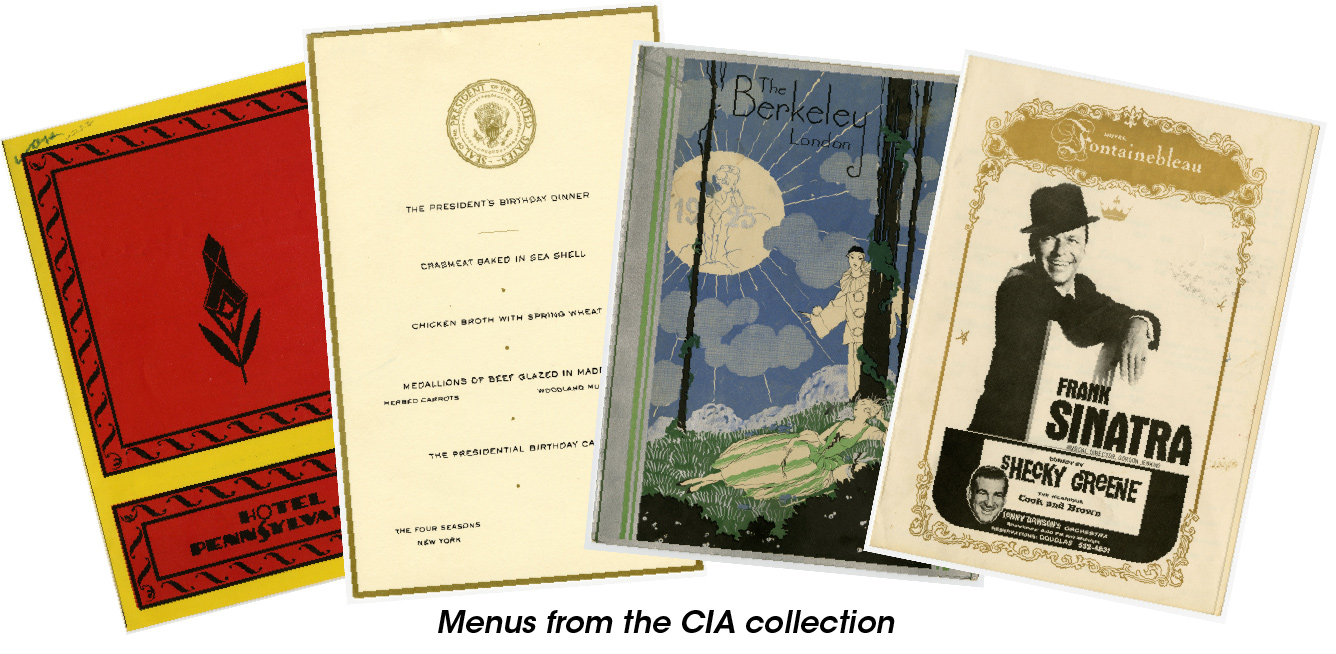
Food comes to life on culinary campus
Grilled salmon with orange-thyme butter, wild rice pilaf with dried cranberries, and green beans with toasted walnut. Forty-clove chicken, whipped potatoes, and oven-roasted vegetables. Wiener schnitzel with lemon-caper beurre blanc, garlic-roasted potatoes with parsley and oregano, and braised greens.
And that's just a taste of what we cooked on the first day of the Best of Boot Camp, a vacation for fans of delectable chow.
This spring, I spent five days at the Culinary Institute of America (CIA for short) preparing luscious dishes with 15 other boot-campers. Clad in chef's whites, we sliced and diced, roasted and grilled, baked and braised like pros, and then gathered around the table to savor our handiwork.
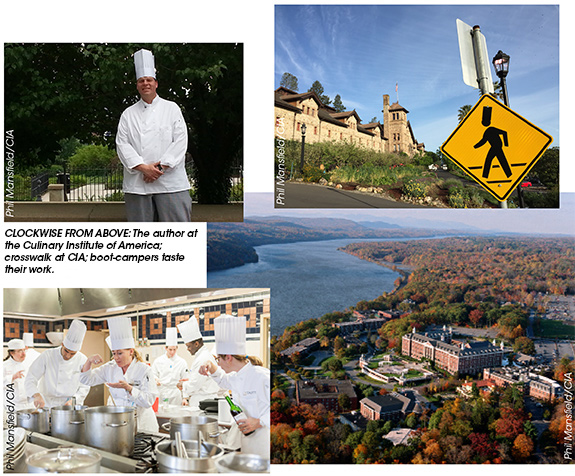
Three years prior, I had dipped my fork into the world of distinguished kitchens by taking basic-training boot camp at the CIA's campus in Hyde Park, N.Y. (See "Yes, Chef: The Joy of Cooking School" in August 2013). The college is known for training famous personalities, including Anthony Bourdain, Cat Cora, Rocco DiSpirito, Amanda Freitag, Sara Moulton, Michael Symon and Geoffrey Zakarian.
Inspired by jam-packed days of learning, cooking and eating, I signed up for similar classes at Central Carolina Community College in Pittsboro. Last month, I received an associate's degree in applied science from its natural chef program. Returning to the CIA was the cherry on top...uh, capstone... of my culinary education.
DAY 1
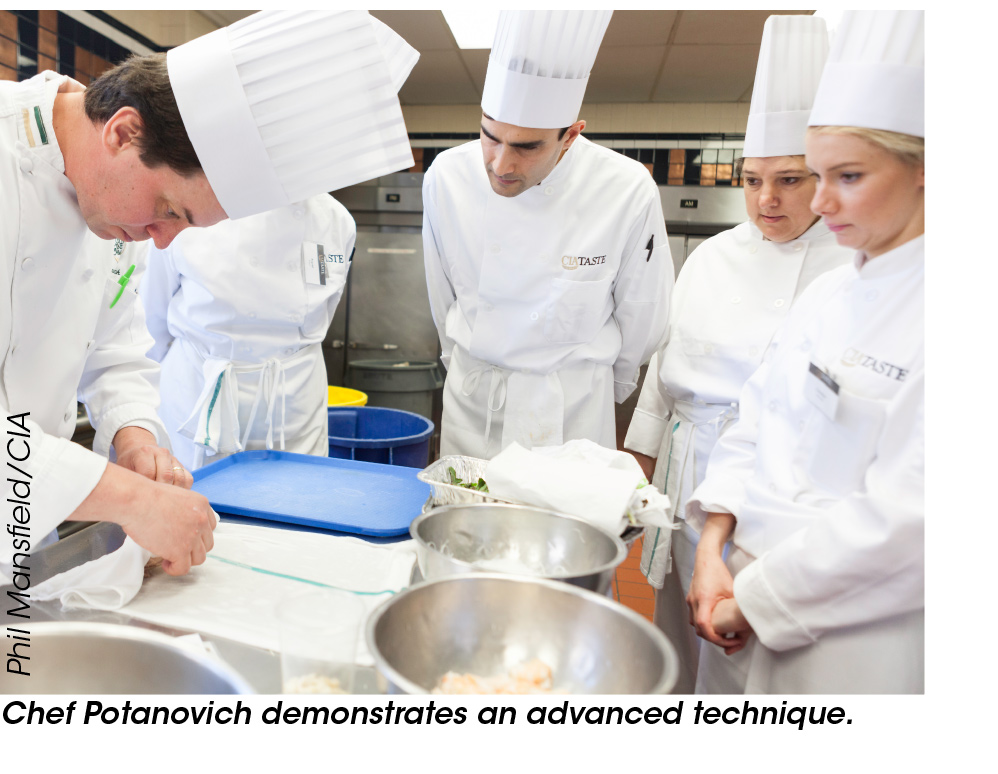 Our instructor is Chef Jason Potanovich, a 1996 CIA graduate who has held fine-dining posts and teaching positions in New York City and other hot spots. He's calm and encouraging. It's as if a pal is showing off mom's recipes. In TV terms, Chef Potanovich is amiable Bobby Flay of Food Network, not mean Gordon Ramsay of "Hell's Kitchen."
Our instructor is Chef Jason Potanovich, a 1996 CIA graduate who has held fine-dining posts and teaching positions in New York City and other hot spots. He's calm and encouraging. It's as if a pal is showing off mom's recipes. In TV terms, Chef Potanovich is amiable Bobby Flay of Food Network, not mean Gordon Ramsay of "Hell's Kitchen."
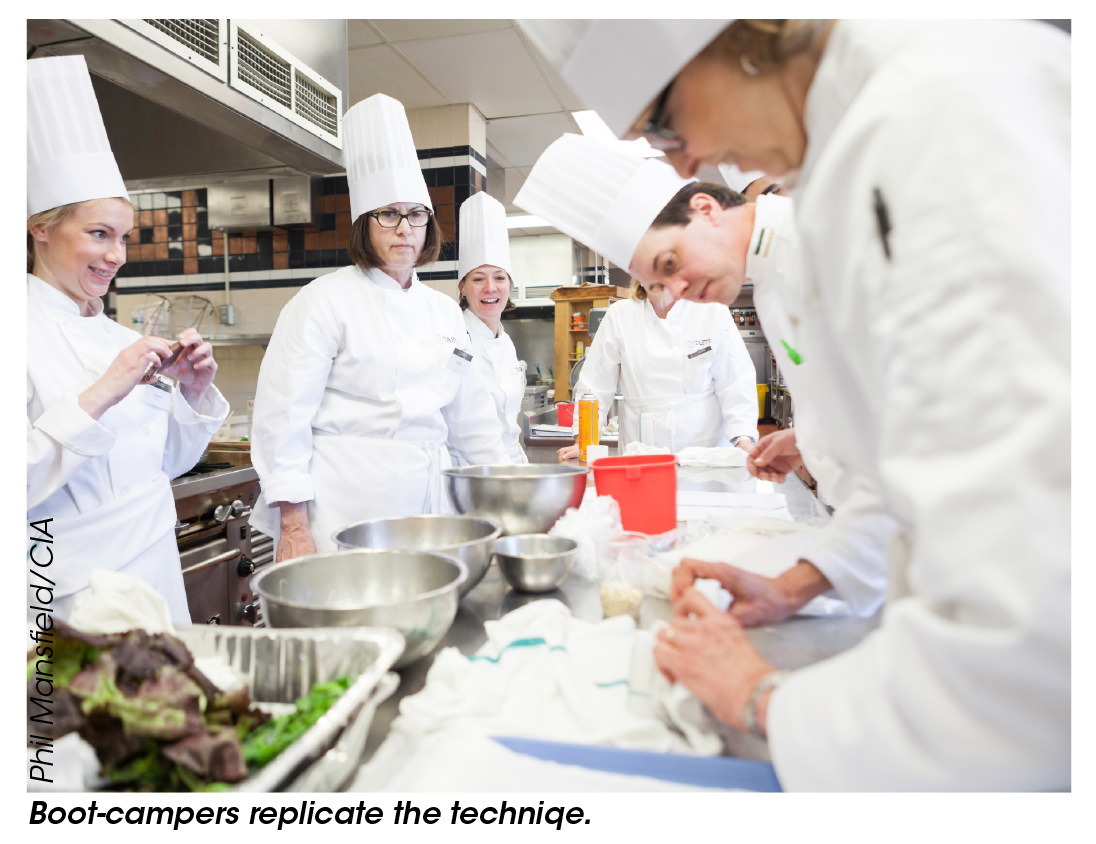 My fellow cooking enthusiasts, primarily women, range from an assistant district attorney to a firefighter to a Federal Reserve economist. Although we've come from all over the country and all walks of life, we're united as a family of foodies.
My fellow cooking enthusiasts, primarily women, range from an assistant district attorney to a firefighter to a Federal Reserve economist. Although we've come from all over the country and all walks of life, we're united as a family of foodies.
After lectures and demonstrations by Chef, the group breaks into four teams who work together each day from 7 a.m. to 2 p.m. Along with his lead assistant, Yafreicy Rodrigues Aries (aka Yaya), and a few other students, he whips up enthusiasm as we create the first day's tempting fare, including the recipes that follow.
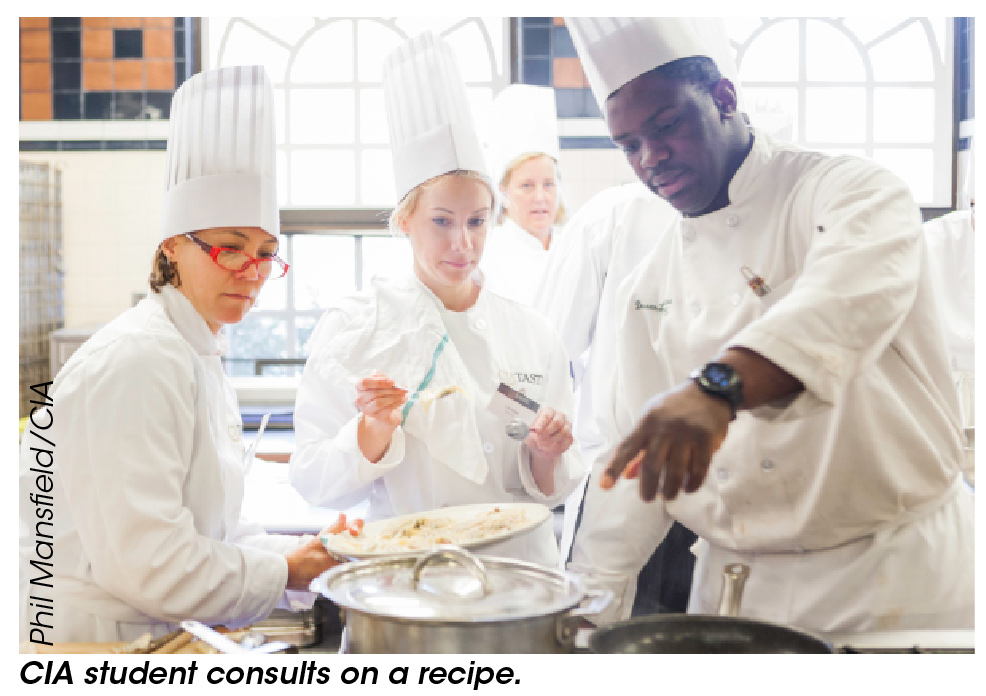 Later, there's a tour of the handsome Hudson River Valley campus from Lorrie Gierloff, who runs the boot camps. She shows off five gourmet restaurants that are staffed by students, including one – American Bounty - helmed by Potanovich. Annually, she notes, the college uses more than 1 million fresh eggs, 200,000 pounds of potatoes, 32,000 pounds of 30 different types of chocolate, and 50,000 pounds of 120 varieties of cheese.
Later, there's a tour of the handsome Hudson River Valley campus from Lorrie Gierloff, who runs the boot camps. She shows off five gourmet restaurants that are staffed by students, including one – American Bounty - helmed by Potanovich. Annually, she notes, the college uses more than 1 million fresh eggs, 200,000 pounds of potatoes, 32,000 pounds of 30 different types of chocolate, and 50,000 pounds of 120 varieties of cheese.
Roast Sirloin of Beef with Jus Lié
Beef sirloin, boneless tied at 1-inch intervals — 3 lb.
Salt — as needed
Ground black pepper — as needed
Vegetable oil — as needed
Onion, diced — 1/3 cup
Carrot, diced — 1/4 cup
Celery, diced — 1/4 cup
Tomato paste — 2 Tbsp.
Brown veal stock — 2-1/2 cups
Cornstarch — 1 tsp.
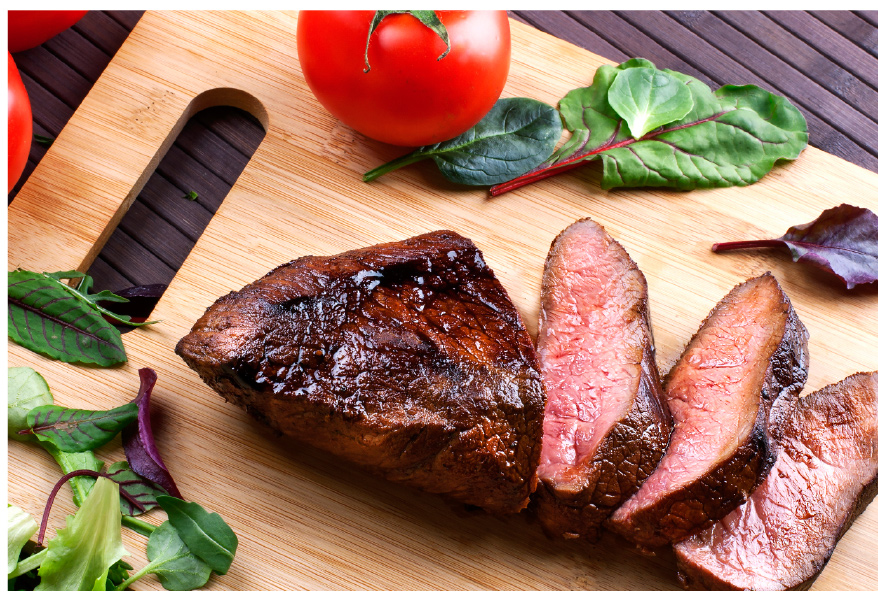 Method
Method
1. Place a rack in a roasting pan and preheat an oven to 350°F.
2. Season the meat generously with salt and pepper.
3. Heat enough oil to create a film in a large sauté pan over medium-high heat and brown the meat on all sides. Transfer to the roasting pan. Add the onions, carrots, and celery to the bottom of the roasting pan.
4. Roast the meat to medium-rare (125°F internal temperature), about 1 hour. Remove from the pan and place on a platter or cutting board, cover loosely with foil, and let stand for 20 minutes while you make the jus.
5. Pour off the fat from the pan, leaving 1 Tbsp. and add the tomato paste. Place the pan over medium heat on the stove top and cook the vegetables and tomato paste, stirring until caramelized, 3 to 5 minutes. Add the stock and stir and scrape with a wooden spoon to deglaze the bottom of the pan.
6. Blend the cornstarch with 1 Tbsp. of water and whisk into the sauce. Bring to a boil over medium heat. As soon as the sauce thickens, remove from the heat and strain. Season to taste with salt and pepper.
7. Remove the string from the meat, slice, and serve on a heated platter with the jus.
Yield: 6 portions
Day 2
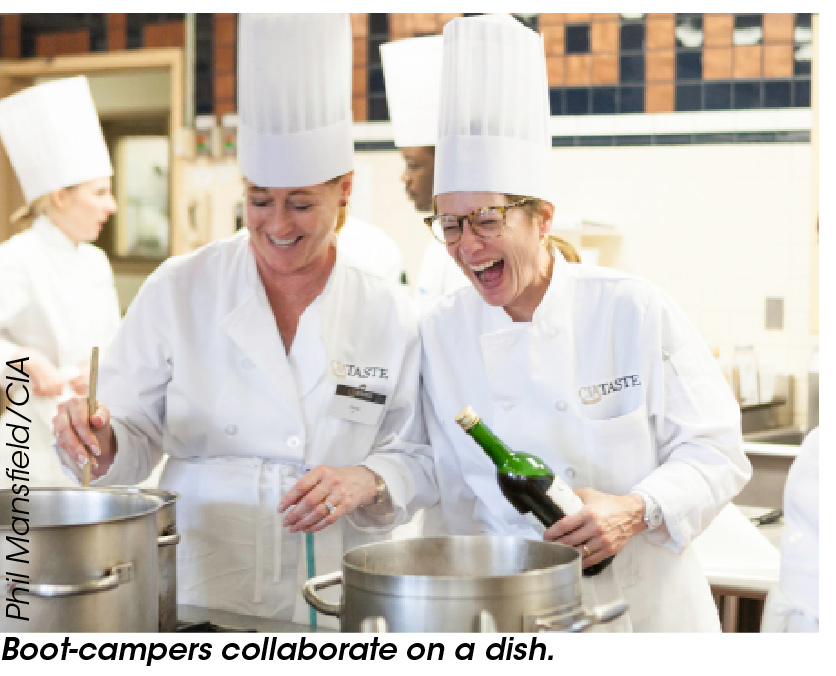 Mangia - we're going to Italy! Chef presents a culinary excursion through the country to see how its cuisine varies from north to south. The focus is on minimally processed ingredients as well as low consumption of animal fats and prolific use of plant foods.
Mangia - we're going to Italy! Chef presents a culinary excursion through the country to see how its cuisine varies from north to south. The focus is on minimally processed ingredients as well as low consumption of animal fats and prolific use of plant foods.
Team One prepares risotto with porcini mushrooms and peas; prosciutto with roasted peppers and anchovies; and garganelli (tubular pasta) with ragù Bolognese (meat sauce).
Team Two (mine!) turns out gnocchetti (small potato dumplings) with peas and pancetta (recipe follows); roast stuffed pork loin Genoa-style; and stuffed zucchini.
Team Three makes fresh mozzarella from curds for a salad; sea bass with vegetables; and baked rolled pasta.
Team Four puts the accent on caponata (eggplant relish) with toast; spinach and ricotta ravioli; and onions in sweet and sour sauce.
After indulging in all the pasta, I'm happy to take a swim in the indoor pool at the Hampton Inn & Suites, a 10-minute drive down Route 9 in Poughkeepsie, where I'm staying for the week.
The only lodgings in Hyde Park itself are inns. Two of the boot-campers have serious complaints about their pricey bed-and-breakfast, and they're disappointed when they can't move to the Hampton Inn because it's sold out.
The Hampton Inn staff gives excellent suggestions for places to visit in the historic region. During my free afternoons, I stroll through the artsy towns of Woodstock, New Palz and Rhinebeck; browse the flea market in Beacon; and tour the Franklin D. Roosevelt presidential library and home, Vanderbilt Mansion and Eleanor Roosevelt National Historic Site.
Gnocchetti with Peas and Pancetta
Dry Pesto
Garlic clove, minced — 4 each
Flat-leaf parsley, chopped — 3-1/2 Tbsp.
Basil, chopped — 2-1/2 Tbsp.
Pine nuts, toasted, crushed — 1/2 cup
Pecorino Romano, grated — 1/4 cup
Stuffing
Ground Pork — 1/4 lb.
Italian sausage, casing removed — 1/4 lb.
Breadcrumbs — 1/2 cup
Heavy cream — 3 Tbsp.
Egg, beaten — 1 each
Pork loin, boneless, well trimmed — 2 lbs.
Salt — as needed
Ground black pepper — as needed
Caul fat, 12-inch x 12-inch — 1 each
Garlic Jus
Onions, diced — 1/2 cup
Carrots, diced — 1/2 cup
Celery, diced — 1/2 cup
Tomato paste — 4 Tbsp.
Garlic clove, minced — 1 each
Bay leaf — 1 each
Brown veal stock — 2-1/4 cups
Salt — to taste
Ground black pepper — to taste
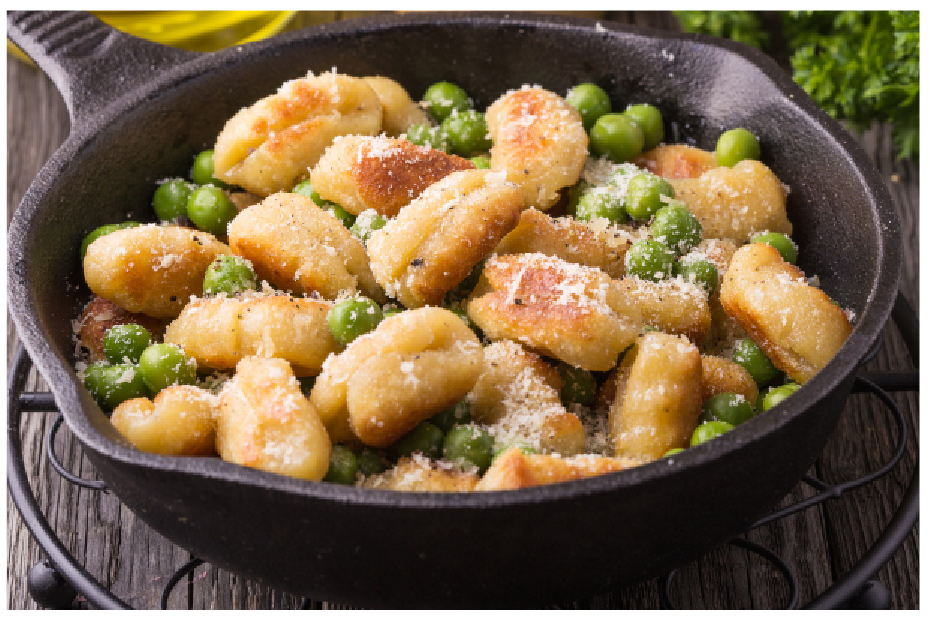 Method
Method
1. Preheat an oven to 350°F.
2. To prepare the dry pesto, combine the garlic, parsley, basil, nuts, and pecorino in a mixing bowl and mix well. Set aside.
3. To prepare the stuffing, combine the ground pork, sausage, breadcrumbs, heavy cream, and egg in a mixing bowl and mix well. Set aside.
4. Butterfly the pork loin then pound lightly with a meat mallet. Season with salt and pepper.
5. Spread the pesto mixture over the pork, then spread the stuffing over the pesto, leaving a 1/2-inch border on all sides.
6. Roll up the pork loin, jelly roll fashion; wrap in fat and secure with butcher's twine.
7. Place a rack in a roasting pan, and put the pork on the rack. Roast the pork in a 350°F oven until the internal temperature reaches 150°F. Remove from oven and place the pork on a cutting board, tent with foil, and allow meat to rest.
8. To prepare the jus, drain the fat from the roasting pan, leaving 1 Tbsp. Add the onions, carrots, celery, and tomato paste to the roasting pan. Place the pan over medium-high heat on the stovetop, and caramelize the vegetables lightly.
9. Add the garlic and sauté until aromatic, about 1 minute. Add the bay leaf and stock. Simmer to reduce the jus to approximately 1-1/2 cups. Strain, then season with salt and pepper to taste. Reserve hot.
10. Remove the string from the pork loin, and slice into 1/4- to 1/2-inch thick slices. Serve on a warmed platter with the jus.
Yield: 6 portions
Excerpted from Fresh Fish © Jennifer Trainer Thompson. Used with permission of Storey Publishing.
Day 3
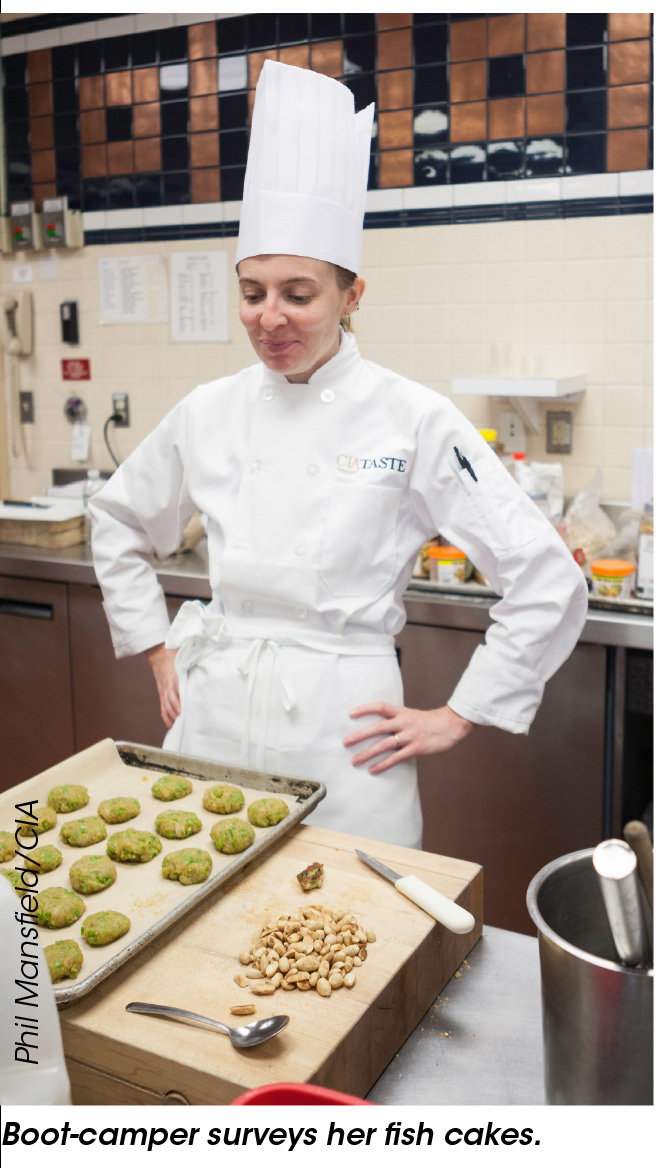 Today, Chef is taking our palates to the continent of Asia. He explores the use of spices to add complexity and depth of flavor to recipes. The cooking methods include frying, grilling, steaming, simmering, boiling, roasting and, my favorite, one-pot cooking.
Today, Chef is taking our palates to the continent of Asia. He explores the use of spices to add complexity and depth of flavor to recipes. The cooking methods include frying, grilling, steaming, simmering, boiling, roasting and, my favorite, one-pot cooking.
Team One delivers Japanese and Korean chart-busters: Kimchi; vegetable tempura; beef teriyaki; and stir-fried glass noodles.
Team Two pulls off Thai green papaya salad; fish cakes with spicy cucumber salad (recipe follows); tofu with red curry sauce; and pad Thai.
Team Three creates crispy Saigon crepes with cilantro-lime soy sauce; rice paper wrapped salad rolls with Vietnamese dipping sauce; Vietnamese chicken curry with sweet potatoes; and coconut rice.
Team Four focuses on China with spicy Napa cabbage; red cooked pork belly; spicy grandmother's tofu; and potstickers.
After lunch, I spend a fascinating afternoon with fellow boot-campers at the school's Conrad L. Hilton Library, where the culinary collection – including 30,000 menus - is second only to the Library of Congress.
Archivist Nicole Semenchuk, formerly of the Smithsonian in Washington, D.C., patiently guides us through the original menus, pointing out how they reveal the tastes of their times. There are menus from 50 states and 80 countries as well as ships, railroads and airlines. "Bill of Fair" reads the oldest, an 1855 piece for Clifton House in Niagara Falls, Canada.
The menus give us chuckles (a 1950s room-service list from the Durham Holiday Inn) and surprises ($2.25 for a deluxe dinner in 1937). They're significant due to reasons cultural (a photo of Frank Sinatra on a menu from a Miami Beach hotel) and historical (President Kennedy's birthday dinner in 1962; later that evening, Marilyn Monroe sang a sultry "Happy Birthday, Mr. President").
Thai Fish Cakes with Spicy Cucumber Salad
Thai bird chiles (hotter than habanero chiles) — 6 each
Shallot, peeled — 1 each
Garlic cloves, peeled — 2 each
Cilantro, coarsely chopped — 2 Tbsp.
Galangal, peeled and minced
(a plant in the ginger family) — 1 Tbsp.
Kaffir lime leaves — 3 each
Salt — 1 Tbsp.
White-fleshed fish fillet, bones removed — 1 lb.
Fish sauce — 2 Tbsp.
Long beans, sliced into paper-thin rounds — 1 cup
Peanut oil (for frying) — as needed
Spicy Thai Cucumber Salad — 1x recipe
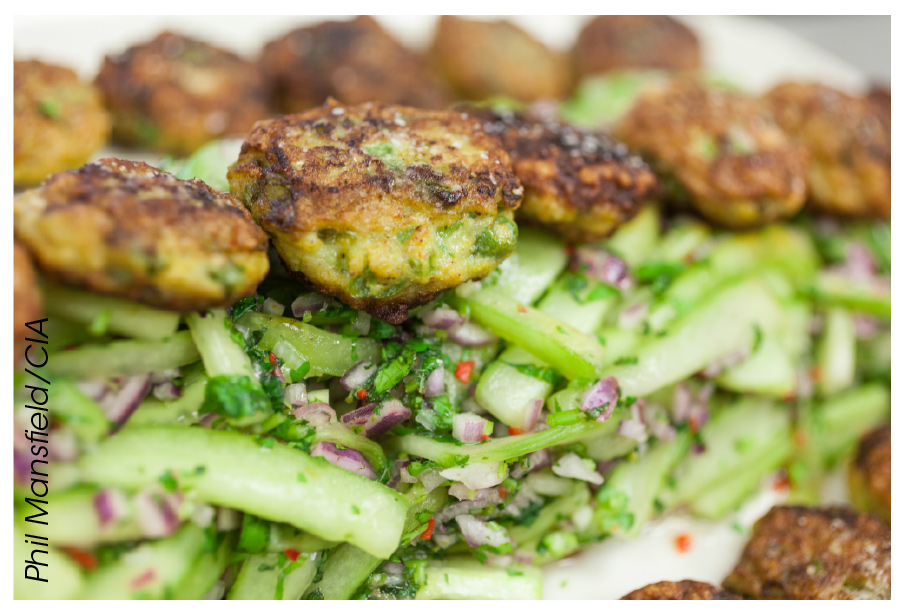 Method
Method
1. Combine the chiles, shallots, garlic, cilantro, galangal, lime leaves, and salt. Grind to a paste using a mortar and pestle.
2. Chop the fish in a food processor to form a coarse paste.
3. Combine the spice paste, fish paste, fish sauce, and sliced beans in a bowl and stir until well combined and slightly sticky in consistency.
4. Shape the mixture into 12 round, flat cakes. Refrigerate until ready to cook.
5. Preheat the peanut oil in a deep fryer to 350°F.
6. Fry the fish cakes in a basket until they are golden on the outside and they float to the top of the oil.
7. Remove from the oil and drain on a wire rack.
Serve hot on a heated platter accompanied by the Spicy Thai Cucumber Salad (recipe can be found below).
Yield: 6 portions.
Spicy Thai Cucumber Salad
European cucumbers — 3 each
Lime juice — 1/2 cup
Sugar — 1/4 cup
Salt — to taste
Thai bird's eye chiles, finely sliced — 3 each
Red onion, finely minced — 1 each
Mint, cut coarsely — 1/2 bunch
Cilantro, coarsely cut — 1/2 bunch
Garnish
Peanuts, roasted, chopped — 5 Tbsp.
1. Peel the cucumbers, cut in half lengthwise, remove all seeds, and cut into thin slices. Place into a mixing bowl.
2. Add all the other ingredients (except for the peanuts) and toss to combine. Let stand for 15 minutes.
3. Taste and adjust seasoning as necessary.
4. Serve garnished with the chopped peanuts.
Yield: 6 portions.
Day 4
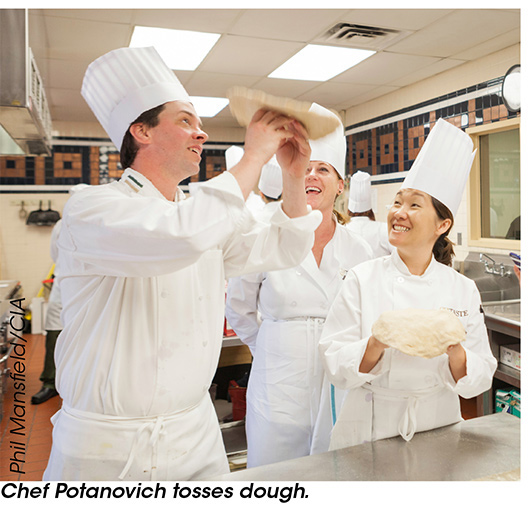 It's the perfect day to eat dessert first! Flour is flying as Chef shows how to turn out challah and ciabatta breads as well as cookies, cupcakes and other sweets. During the first three days, he encourages us to add a pinch of this and a snip of that as we perfect the dishes. But the creativity of that savory cooking yields to the math and science of baking.
It's the perfect day to eat dessert first! Flour is flying as Chef shows how to turn out challah and ciabatta breads as well as cookies, cupcakes and other sweets. During the first three days, he encourages us to add a pinch of this and a snip of that as we perfect the dishes. But the creativity of that savory cooking yields to the math and science of baking.
Team One bakes apple pie and mudslide cookies; Team Two, butterscotch cookies and almond crescent cookies (recipe follows); Team Three, small French tea cakes and Scottish shortbread cookies; and Team Four, Mexican wedding cookies and double chocolate cupcakes.
Following an afternoon break for our stomachs, the group heads to American Bounty, where our Chef holds the position of executive chef. The menu pays homage to the Hudson River Valley's farmers, artisans, bakers and vintners and focuses on seasonal, sustainable ingredients. Faves include spring pea soup, Island Creek oysters, bison tenderloin and vanilla bean cheesecake. As we exit, still mesmerized by dinner, Chef signs each of our menus.
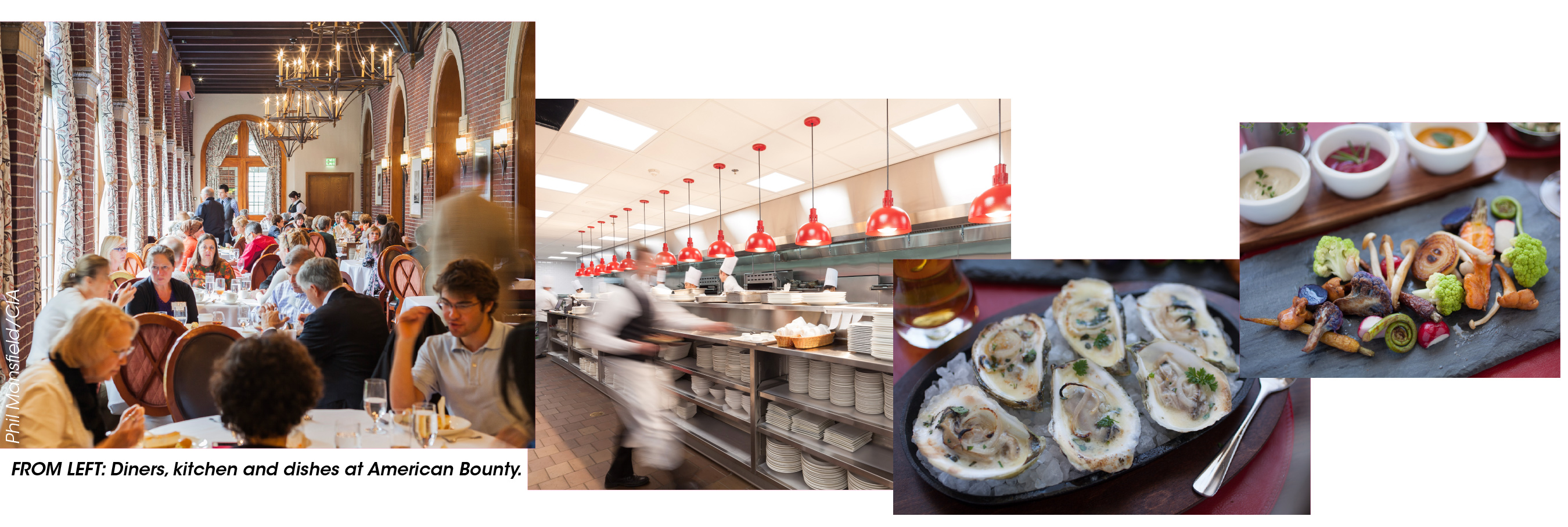
Almond Crescent Cookies
Almond paste — 4 cups (910 g)
Sugar — 2-1/4 cups (455 g)
Lemon zest — to taste
Egg whites — 7 wt. oz. (200 g)
Almonds, sliced, crushed — 8 - 10 wt. oz. (225 - 285 g)
Simple syrup — as needed
Honey — to taste
Chocolate coating, melted — as needed
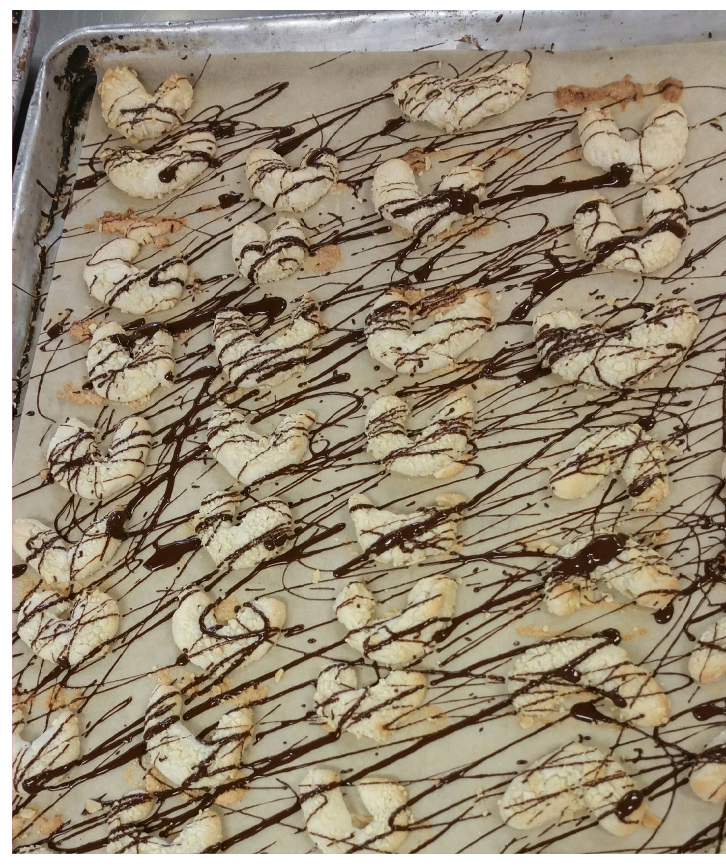 Method
Method
1. Combine the almond paste, sugar, and lemon zest in the bowl of a stand mixer fitted with the paddle attachment. Mix until the ingredients are the size of small peas.
2. Add the egg whites in 5 additions, mixing and scraping down the sides of the bowl before adding the next portion.
3. Place the crushed almonds on a sheet tray. Place the dough in a piping bag fitted with a #6 tip. Pipe 2-inch pieces of the dough onto the almonds.
4. Preheat an oven to 350°F. Line several double-sheet pans with parchment paper.
5. Transfer the cookies to the parchment lined sheet pans. Bake in the oven until light brown.
6. While the cookies are baking, flavor the simple syrup with the honey.
7. Remove the cookies from the oven and glaze with the simple syrup. Allow to cool completely. Once cool, drizzle with chocolate or dip each end in the chocolate coating. Allow to cool.
Yield: 100 cookies.
Day 5
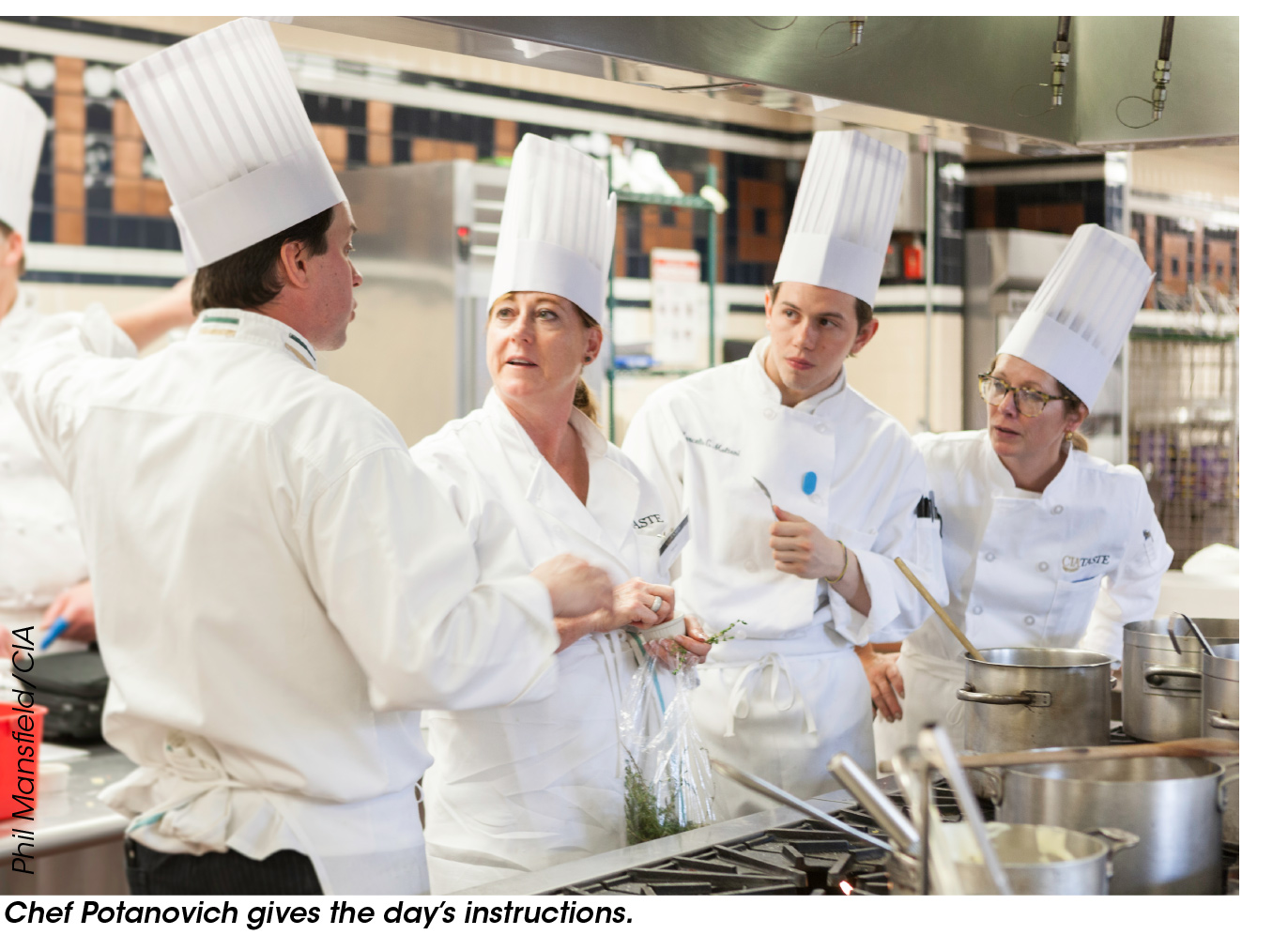 For the last day, the cuisine of French bistros is on the menu. Throughout France, Chef explains, these small, neighborhood spots offer unpretentious, local food. Almost immediately, comforting aromas begin to waft from every corner of our kitchen.
For the last day, the cuisine of French bistros is on the menu. Throughout France, Chef explains, these small, neighborhood spots offer unpretentious, local food. Almost immediately, comforting aromas begin to waft from every corner of our kitchen.
Team One gets going with French onion soup; potato, onion and rosemary pizza; coq au vin (chicken braised with wine); and buttered noodles.
Team Two makes potage au pisou (fresh vegetable soup); frisee au lardons (a salad); caramelized onion quiche with brie and smoked salmon; and croque monsieur (grilled ham and cheese sandwich).
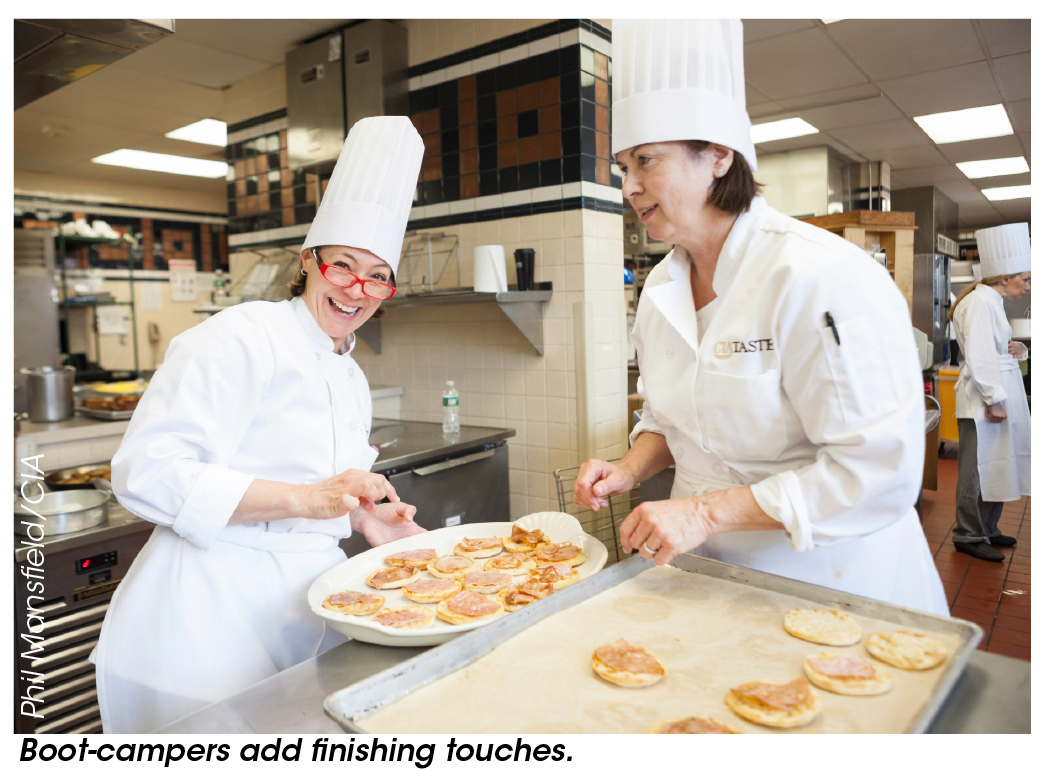 Team Three builds Hudson Valley Camembert crisp with apple-pear conserve; steak frits; mushrooms, leek and brie turnovers; and crepes with mixed berry filling.
Team Three builds Hudson Valley Camembert crisp with apple-pear conserve; steak frits; mushrooms, leek and brie turnovers; and crepes with mixed berry filling.
Team Four puts together Provencal salad with red wine vinaigrette; mussels in saffron and white wine broth (recipe follows); eggs Benedict; and cream scones.
At our last glorious lunch, Chef presents each person with a certificate during a graduation ceremony brimming with shout-outs, snapshots, handshakes and hugs. I find myself lingering at the table with my new friends...and not just to lick the cream off the remaining scones.
Mussels in Saffron and White Wine Broth
Butter — 1 Tbsp.
Garlic cloves, chopped — 2 ea.
Dry white wine — 1/3 cup
Half & half — 2 tsp.
Saffron threads — 1 tsp.
Clam juice — 1/3 cup
Green onion, thinly sliced — 1 ea.
Tomato, seeded, and chopped — 1 ea.
Lemon juice — 1 Tbsp.
Mussels, scrubbed and debearded — 3 lbs.
Chives, chopped — 1 Tbsp.
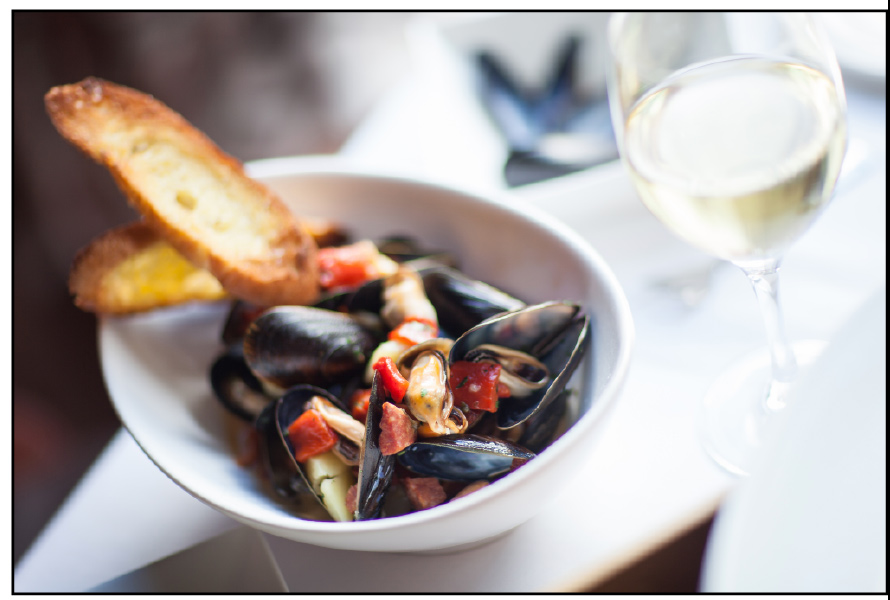 Method
Method
1. Melt the butter in a medium pot over medium heat, then add the garlic. Sauté until the garlic is fragrant, about 1 minute. Add the wine, half & half, and saffron; simmer for 5 minutes.
2. Add the clam juice, green onions, tomato, and lemon juice; simmer for 5 minutes.
3. Add the mussels, cover, and steam until they open, about 5 to 7 minutes. Shake the pot, holding down the lid with a kitchen towel, to redistribute the mussels. Discard any mussels that do not open.
4. Serve the mussels in their sauce in a large heated platter or bowl and top with fresh chives.
Yield: 16 portions.
